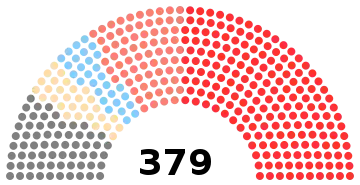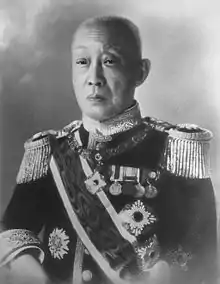| |||||||||||||||||||||||||||||||||||||||||||||||||||||||||||
All 379 seats in the House of Representatives 190 seats needed for a majority | |||||||||||||||||||||||||||||||||||||||||||||||||||||||||||
|---|---|---|---|---|---|---|---|---|---|---|---|---|---|---|---|---|---|---|---|---|---|---|---|---|---|---|---|---|---|---|---|---|---|---|---|---|---|---|---|---|---|---|---|---|---|---|---|---|---|---|---|---|---|---|---|---|---|---|---|
| |||||||||||||||||||||||||||||||||||||||||||||||||||||||||||
| |||||||||||||||||||||||||||||||||||||||||||||||||||||||||||
| This article is part of a series on |
| Politics of Japan |
|---|
 |
|
|
General elections were held in Japan on 15 May 1908.[1] The result was a victory for the Rikken Seiyūkai party, which won 187 of the 379 seats.
Electoral system
The 379 members of the House of Representatives were elected in 51 multi-member constituencies based on prefectures and cities. Voting was restricted to men aged over 25 who paid at least 10 yen a year in direct taxation.[2]
Campaign
A total of 900 candidates contested the 379 seats.
Results
 | |||||
|---|---|---|---|---|---|
| Party | Votes | % | Seats | +/– | |
| Rikken Seiyūkai | 649,858 | 48.40 | 187 | +54 | |
| Kensei Hontō | 288,243 | 21.47 | 70 | –20 | |
| Yūkōkai | 99,690 | 7.42 | 29 | New | |
| Daidō Club | 92,477 | 6.89 | 29 | –29 | |
| Others | 212,377 | 15.82 | 64 | +9 | |
| Total | 1,342,645 | 100.00 | 379 | 0 | |
| Valid votes | 1,342,645 | 99.00 | |||
| Invalid/blank votes | 13,534 | 1.00 | |||
| Total votes | 1,356,179 | 100.00 | |||
| Registered voters/turnout | 1,590,045 | 85.29 | |||
| Source: Mackie & Rose | |||||
Notes
References
This article is issued from Wikipedia. The text is licensed under Creative Commons - Attribution - Sharealike. Additional terms may apply for the media files.
